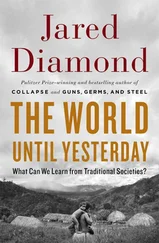Jared Diamond - Guns, Germs & Steel
Здесь есть возможность читать онлайн «Jared Diamond - Guns, Germs & Steel» весь текст электронной книги совершенно бесплатно (целиком полную версию без сокращений). В некоторых случаях можно слушать аудио, скачать через торрент в формате fb2 и присутствует краткое содержание. Жанр: 105. Описание произведения, (предисловие) а так же отзывы посетителей доступны на портале библиотеки ЛибКат.
- Название:Guns, Germs & Steel
- Автор:
- Жанр:
- Год:неизвестен
- ISBN:нет данных
- Рейтинг книги:5 / 5. Голосов: 1
-
Избранное:Добавить в избранное
- Отзывы:
-
Ваша оценка:
- 100
- 1
- 2
- 3
- 4
- 5
Guns, Germs & Steel: краткое содержание, описание и аннотация
Предлагаем к чтению аннотацию, описание, краткое содержание или предисловие (зависит от того, что написал сам автор книги «Guns, Germs & Steel»). Если вы не нашли необходимую информацию о книге — напишите в комментариях, мы постараемся отыскать её.
Guns, Germs & Steel — читать онлайн бесплатно полную книгу (весь текст) целиком
Ниже представлен текст книги, разбитый по страницам. Система сохранения места последней прочитанной страницы, позволяет с удобством читать онлайн бесплатно книгу «Guns, Germs & Steel», без необходимости каждый раз заново искать на чём Вы остановились. Поставьте закладку, и сможете в любой момент перейти на страницу, на которой закончили чтение.
Интервал:
Закладка:
YALI'S PEOPLE • 315
lacked pigs, pottery, and bows and arrows. Furthermore, the strait is not an open-water barrier but is dotted with a chain of islands, of which the largest (Muralug Island) lies only 10 miles from the Australian coast. There were regular trading visits between Australia and the islands, and between the islands and New Guinea. Many Aboriginal women came as wives to Muralug Island, where they saw gardens and bows and arrows. How was it that those New Guinea traits did not get transmitted to Australia?
This cultural barrier at Torres Strait is astonishing only because we may mislead ourselves into picturing a full-fledged New Guinea society with intensive agriculture and pigs 10 miles off the Australian coast. In reality, Cape York Aborigines never saw a mainland New Guinean. Instead, there was trade between New Guinea and the islands nearest New Guinea, then between those islands and Mabuiag Island halfway down the strait, then between Mabuiag Island and Badu Island farther down the strait, then between Badu Island and Muralug Island, and finally between Muralug and Cape York.
New Guinea society became attenuated along that island chain. Pigs were rare or absent on the islands. Lowland South New Guineans along Torres Strait practiced not the intensive agriculture of the New Guinea highlands but a slash-and-burn agriculture with heavy reliance on seafoods, hunting, and gathering. The importance of even those slash-and-burn practices decreased from southern New Guinea toward Australia along the island chain. Muralug Island itself, the island nearest Australia, was dry, marginal for agriculture, and supported only a small human population, which subsisted mainly on seafood, wild yams, and mangrove fruits.
The interface between New Guinea and Australia across Torres Strait was thus reminiscent of the children's game of telephone, in which children sit in a circle, one child whispers a word into the ear of the second child, who whispers what she thinks she has just heard to the third child, and the word finally whispered by the last child back to the first child bears no resemblance to the initial word. In the same way, trade along the Torres Strait islands was a telephone game that finally presented Cape York Aborigines with something very different from New Guinea society. In addition, we should not imagine that relations between Muralug Islanders and Cape York Aborigines were an uninterrupted love feast at which Aborigines eagerly sopped up culture from island teachers. Trade instead alter-
3 I 6 • GUNS, GERMS, AND STEEL
nated with war for the purposes of head-hunting and capturing women to become wives.
Despite the dilution of New Guinea culture by distance and war, some New Guinea influence, did manage to reach Australia. Intermarriage carried New Guinea physical features, such as coiled rather than straight hair, down the Cape York Peninsula. Four Cape York languages had phonemes unusual for Australia, possibly because of the influence of New Guinea languages. The most important transmissions were of New Guinea shell fishhooks, which spread far into Australia, and of New Guinea outrigger canoes, which spread down the Cape York Peninsula. New Guinea drums, ceremonial masks, funeral posts, and pipes were also adopted on Cape York. But Cape York Aborigines did not adopt agriculture, in part because what they saw of it on Muralug Island was so watered-down. They did not adopt pigs, of which there were few or none on the islands, and which they would in any case have been unable to feed without agriculture. Nor did they adopt bows and arrows, remaining instead with their spears and spear-throwers.
Australia is big, and so is New Guinea. But contact between those two big landmasses was restricted to those few small groups of Torres Strait islanders with a highly attenuated New Guinea culture, interacting with those few small groups of Cape York Aborigines. The latter groups' decisions, for whatever reason, to use spears rather than bows and arrows, and not to adopt certain other features of the diluted New Guinea culture they saw, blocked transmission of those New Guinea cultural traits to all the rest of Australia. As a result, no New Guinea trait except shell fishhooks spread far into Australia. If the hundreds of thousands of farmers in the cool New Guinea highlands had been in close contact with the Aborigines in the cool highlands of southeastern Australia, a massive transfer of intensive food production and New Guinea culture to Australia might have followed. But the New Guinea highlands are separated from the Australian highlands by 2,000 miles of ecologically very different landscape. The New Guinea highlands might as well have been the mountains of the moon, as far as Australians' chances of observing and adopting New Guinea highland practices were concerned.
In short, the persistence of Stone Age nomadic hunter-gatherers in Australia, trading with Stone Age New Guinea farmers and Iron Age Indonesian farmers, at first seems to suggest singular obstinacy on the part of Native Australians. On closer examination, it merely proves to reflect the
YALl'S PEOPLE • 317
ubiquitous role of geography in the transmission of human culture and technology.
itremains for usto consider the encounters of new guinea's and australia's stone age societies with iron age Europeans. A Portuguese navigator "discovered" New Guinea in 1526, Holland claimed the western half in 1828, and Britain and Germany divided the eastern half in 1884. The first Europeans settled on the coast, and it took them a long time to penetrate into the interior, but by 1960 European governments had established political control over most New Guineans.
The reasons that Europeans colonized New Guinea, rather than vice versa, are obvious. Europeans were the ones who had the oceangoing ships and compasses to travel to New Guinea; the writing systems and printing presses to produce maps, descriptive accounts, and administrative paperwork useful in establishing control over New Guinea; the political institutions to organize the ships, soldiers, and administration; and the guns to shoot New Guineans who resisted with bow and arrow and clubs. Yet the number of European settlers was always very small, and today New Guinea is still populated largely by New Guineans. That contrasts sharply with the situation in Australia, the Americas, and South Africa, where European settlement was numerous and lasting and replaced the original native population over large areas. Why was New Guinea different?
A major factor was the one that defeated all European attempts to settle the New Guinea lowlands until the 1880s: malaria and other tropical diseases, none of them an acute epidemic crowd infection as discussed in Chapter 11. The most ambitious of those failed lowland settlement plans, organized by the French marquis de Rays around 1880 on the nearby island of New Ireland, ended with 930 out of the 1,000 colonists dead within three years. Even with modern medical treatments available today, many of my American and European friends in New Guinea have been forced to leave because of malaria, hepatitis, or other diseases, while my own health legacy of New Guinea has been a year of malaria and a year of dysentery.
As Europeans were being felled by New Guinea lowland germs, why were Eurasian germs not simultaneously felling New Guineans? Some New Guineans did become infected, but not on the massive scale that
3 I 8 • GUNS, GERMS, ANDsteel
killed off most of the native peoples of Australia and the Americas. One lucky break for New Guineans was that there were no permanent European settlements in New Guinea until the 1880s, by which time public health discoveries had made progress in bringing smallpox and other infectious diseases of European populations under control. In addition, the Austronesian expansion had already been bringing a stream of Indonesian settlers and traders to New Guinea for 3,500 years. Since Asian mainland infectious diseases were well established in Indonesia, New Guineans thereby gained long exposure and built up much more resistance to Eurasian germs than did Aboriginal Australians.
The sole part of New Guinea where Europeans do not suffer from severe health problems is the highlands, above the altitudinal ceiling for malaria. But the highlands, already occupied by dense populations of New Guineans, were not reached by Europeans until the 1930s. By then, the Australian and Dutch colonial governments were no longer willing to open up lands for white settlement by killing native people in large numbers or driving them off their lands, as had happened during earlier centuries of European colonialism.
The remaining obstacle to European would-be settlers was that European crops, livestock, and subsistence methods do poorly everywhere in the New Guinea environment and climate. While introduced tropical American crops such as squash, corn, and tomatoes are now grown in small quantities, and tea and coffee plantations have been established in the highlands of Papua New Guinea, staple European crops, like wheat, barley, and peas, have never taken hold. Introduced cattle and goats, kept in small numbers, suffer from tropical diseases, just as do European people themselves. Food production in New Guinea is still dominated by the crops and agricultural methods that New Guineans perfected over the course of thousands of years.
All those problems of disease, rugged terrain, and subsistence contributed to Europeans' leaving eastern New Guinea (now the independent nation of Papua New Guinea) occupied and governed by New Guineans, who nevertheless use English as their official language, write with the alphabet, live under democratic governmental institutions modeled on those of England, and use guns manufactured overseas. The outcome was different in western New Guinea, which Indonesia took over from Holland in 1963 and renamed Irian Jaya province. The province is now governed by Indonesians, for Indonesians. Its rural population is still
Интервал:
Закладка:
Похожие книги на «Guns, Germs & Steel»
Представляем Вашему вниманию похожие книги на «Guns, Germs & Steel» списком для выбора. Мы отобрали схожую по названию и смыслу литературу в надежде предоставить читателям больше вариантов отыскать новые, интересные, ещё непрочитанные произведения.
Обсуждение, отзывы о книге «Guns, Germs & Steel» и просто собственные мнения читателей. Оставьте ваши комментарии, напишите, что Вы думаете о произведении, его смысле или главных героях. Укажите что конкретно понравилось, а что нет, и почему Вы так считаете.










